Economics Assignment on Microeconomic Principles and Analysis
VerifiedAdded on 2022/09/15
|10
|1430
|22
Homework Assignment
AI Summary
This economics assignment delves into several key microeconomic concepts. It begins by differentiating between explicit and implicit costs, crucial for understanding a firm's financial performance. The assignment then explores the relationship between marginal product and marginal cost, emphasizing how changes in these factors impact total and average costs, consequently affecting a firm's profit. It further examines market structures, contrasting price makers and price takers, and analyzing the characteristics of perfectly competitive and monopolistically competitive markets. The assignment also addresses profit maximization, detailing the conditions firms must meet to maximize profits and the decisions firms must make to minimize losses. Finally, it applies game theory to a real-world scenario, illustrating strategic decision-making through a payoff matrix and identifying Nash equilibria. The document provides a comprehensive overview of microeconomic principles and their practical applications.
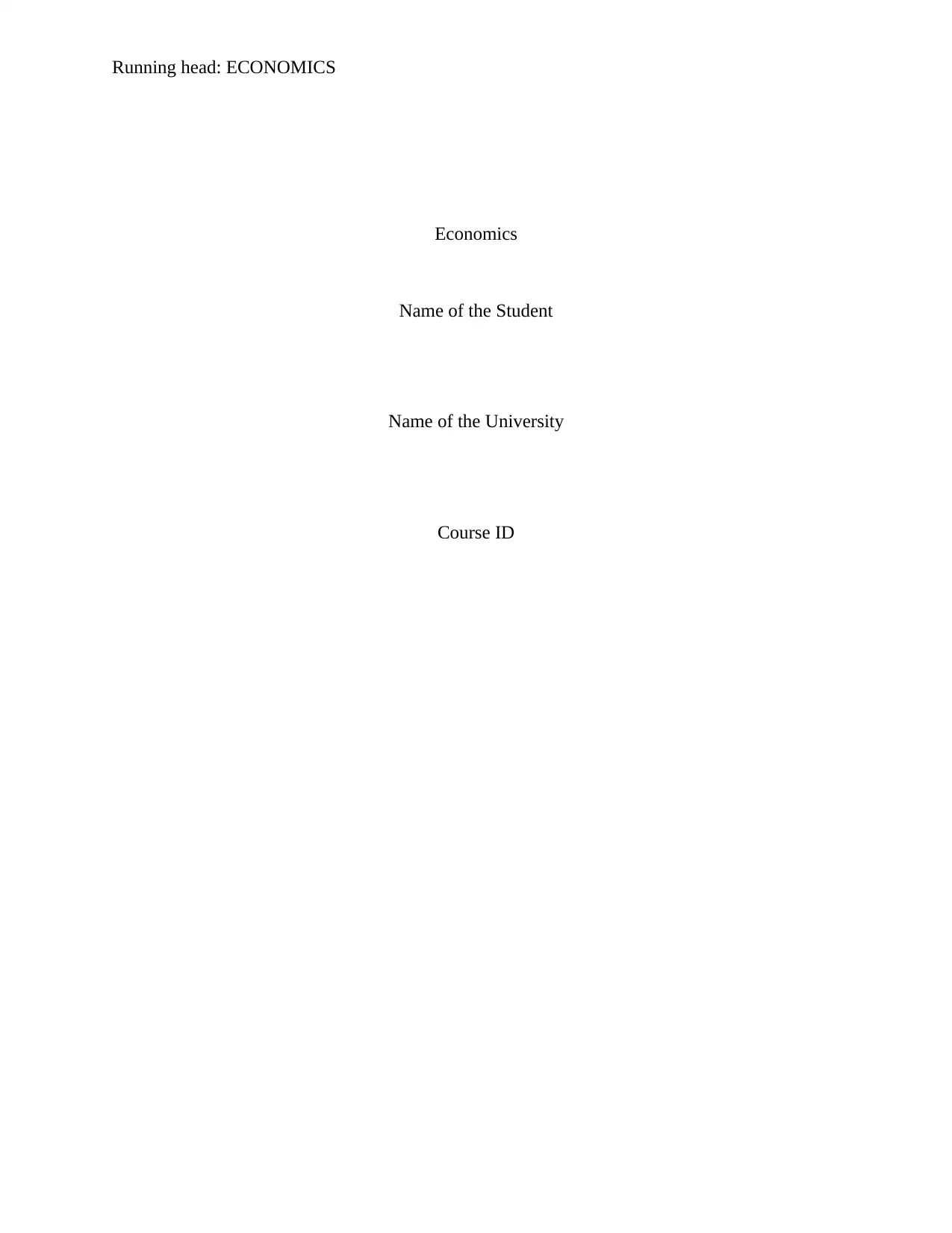
Running head: ECONOMICS
Economics
Name of the Student
Name of the University
Course ID
Economics
Name of the Student
Name of the University
Course ID
Paraphrase This Document
Need a fresh take? Get an instant paraphrase of this document with our AI Paraphraser
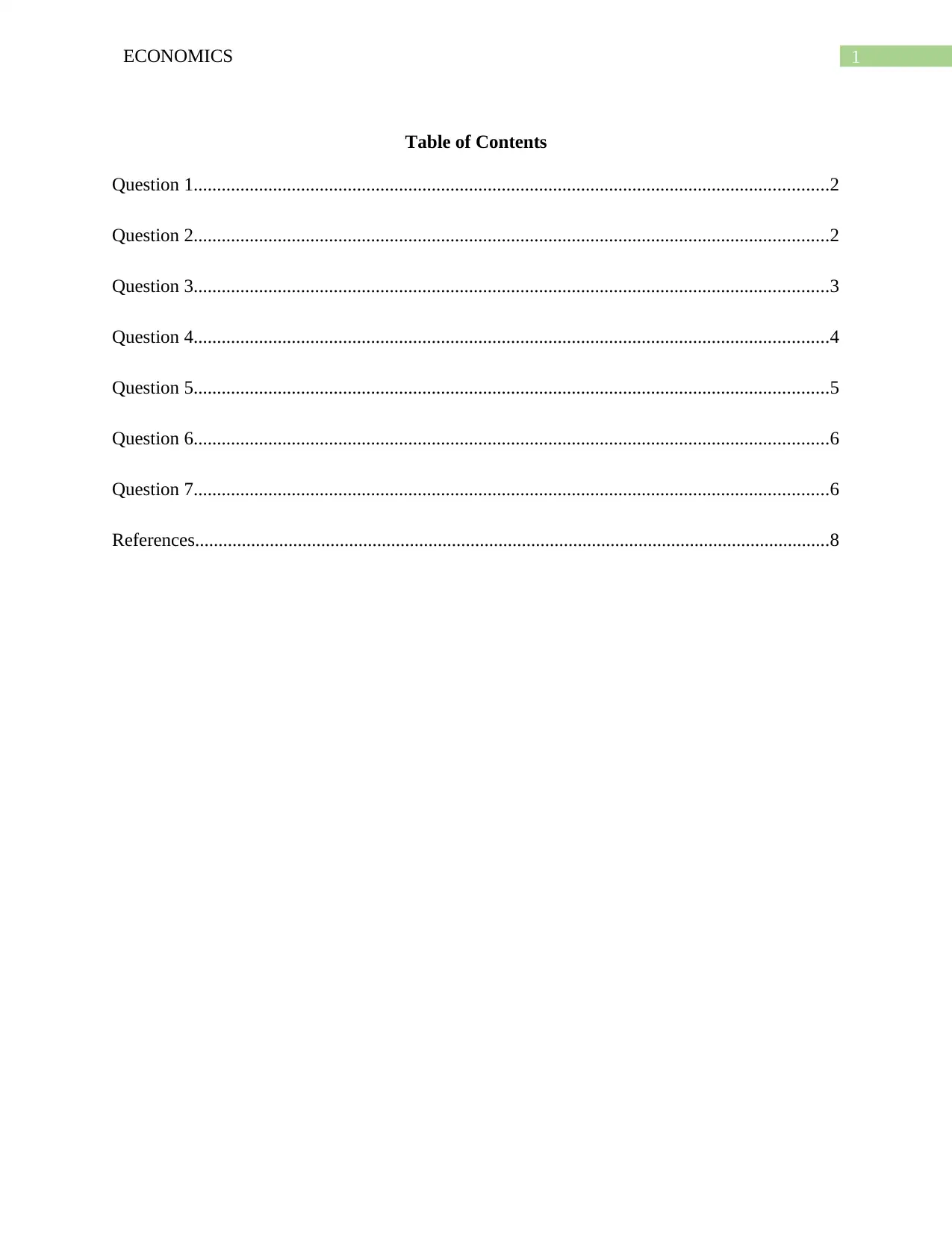
1ECONOMICS
Table of Contents
Question 1........................................................................................................................................2
Question 2........................................................................................................................................2
Question 3........................................................................................................................................3
Question 4........................................................................................................................................4
Question 5........................................................................................................................................5
Question 6........................................................................................................................................6
Question 7........................................................................................................................................6
References........................................................................................................................................8
Table of Contents
Question 1........................................................................................................................................2
Question 2........................................................................................................................................2
Question 3........................................................................................................................................3
Question 4........................................................................................................................................4
Question 5........................................................................................................................................5
Question 6........................................................................................................................................6
Question 7........................................................................................................................................6
References........................................................................................................................................8
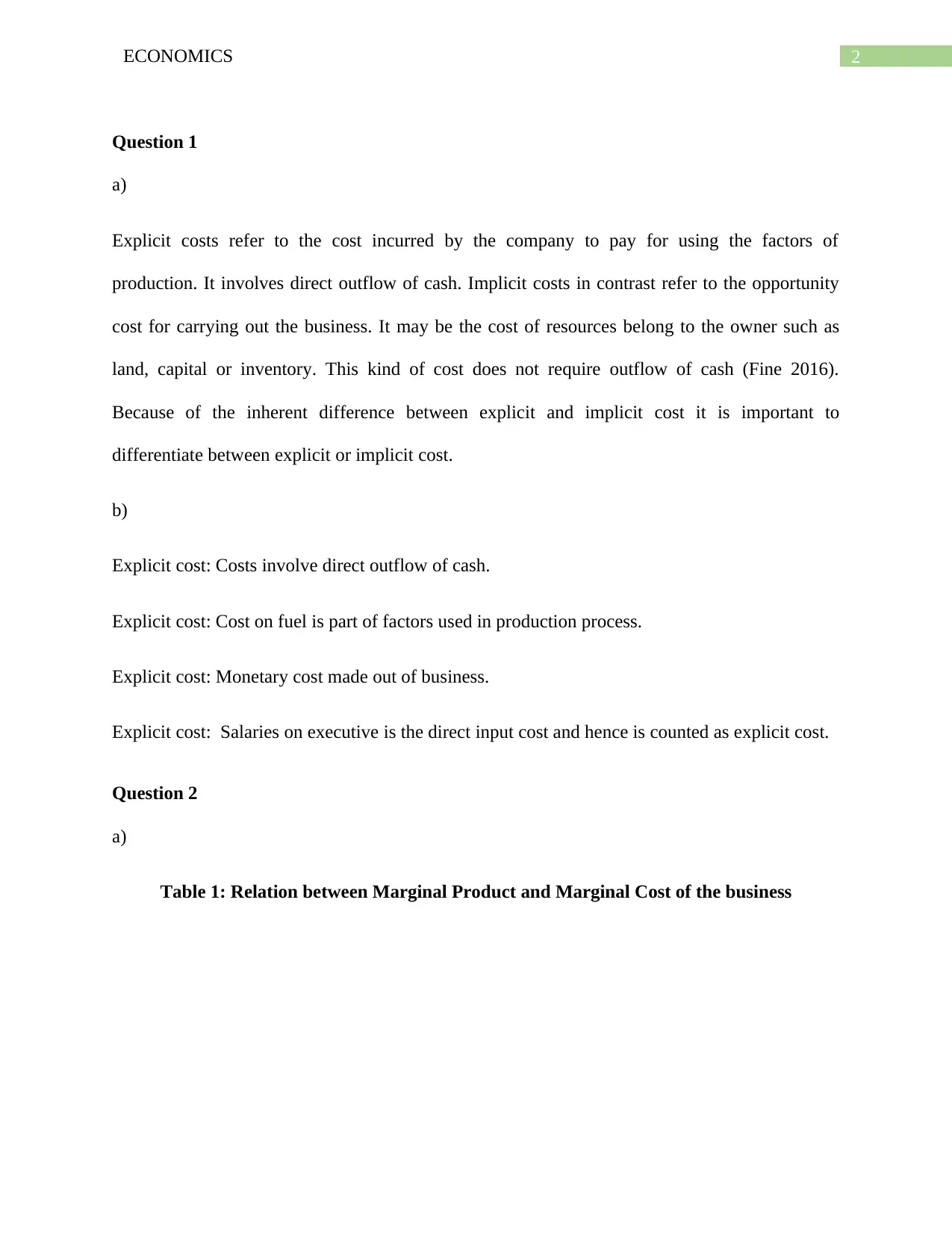
2ECONOMICS
Question 1
a)
Explicit costs refer to the cost incurred by the company to pay for using the factors of
production. It involves direct outflow of cash. Implicit costs in contrast refer to the opportunity
cost for carrying out the business. It may be the cost of resources belong to the owner such as
land, capital or inventory. This kind of cost does not require outflow of cash (Fine 2016).
Because of the inherent difference between explicit and implicit cost it is important to
differentiate between explicit or implicit cost.
b)
Explicit cost: Costs involve direct outflow of cash.
Explicit cost: Cost on fuel is part of factors used in production process.
Explicit cost: Monetary cost made out of business.
Explicit cost: Salaries on executive is the direct input cost and hence is counted as explicit cost.
Question 2
a)
Table 1: Relation between Marginal Product and Marginal Cost of the business
Question 1
a)
Explicit costs refer to the cost incurred by the company to pay for using the factors of
production. It involves direct outflow of cash. Implicit costs in contrast refer to the opportunity
cost for carrying out the business. It may be the cost of resources belong to the owner such as
land, capital or inventory. This kind of cost does not require outflow of cash (Fine 2016).
Because of the inherent difference between explicit and implicit cost it is important to
differentiate between explicit or implicit cost.
b)
Explicit cost: Costs involve direct outflow of cash.
Explicit cost: Cost on fuel is part of factors used in production process.
Explicit cost: Monetary cost made out of business.
Explicit cost: Salaries on executive is the direct input cost and hence is counted as explicit cost.
Question 2
a)
Table 1: Relation between Marginal Product and Marginal Cost of the business
⊘ This is a preview!⊘
Do you want full access?
Subscribe today to unlock all pages.

Trusted by 1+ million students worldwide
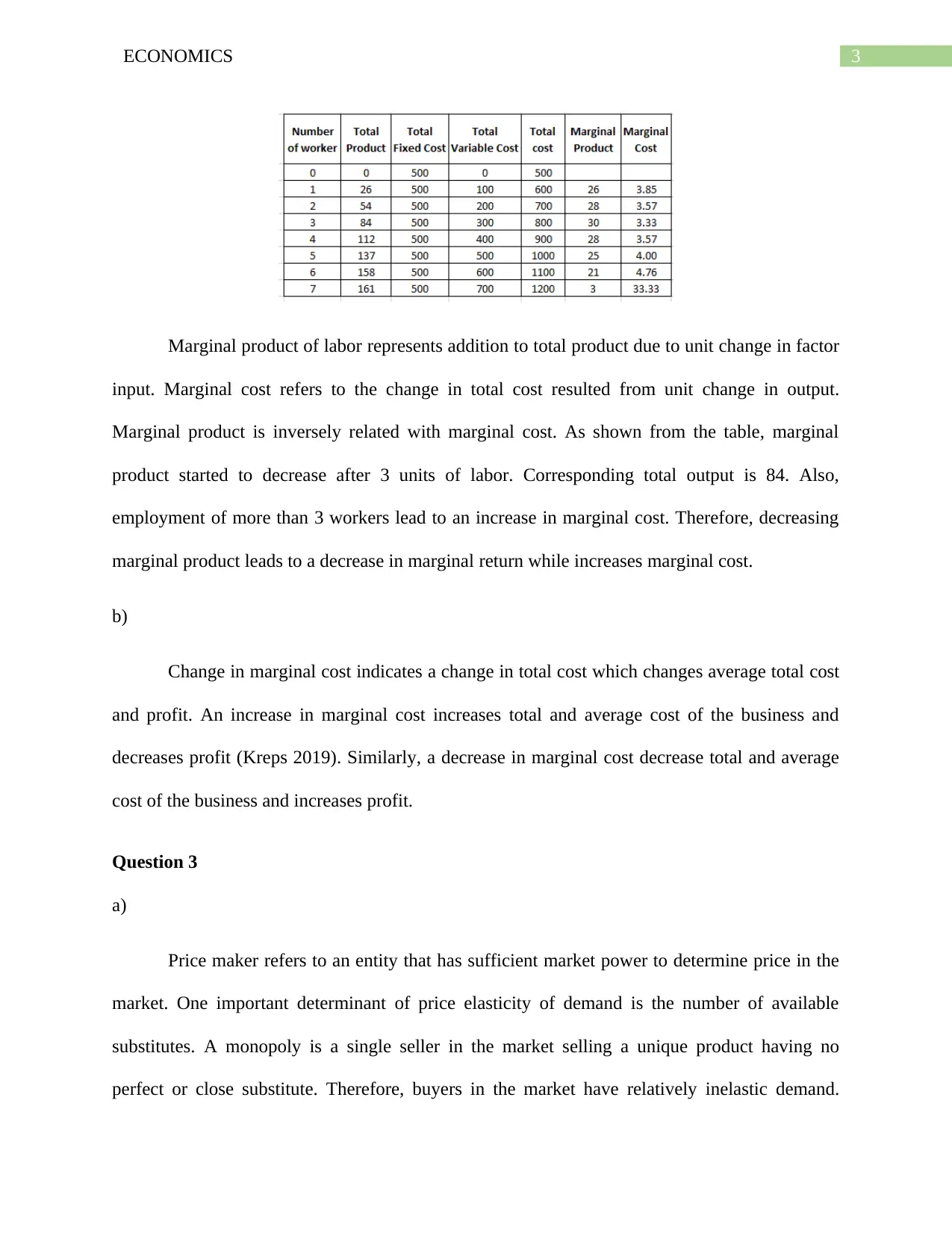
3ECONOMICS
Marginal product of labor represents addition to total product due to unit change in factor
input. Marginal cost refers to the change in total cost resulted from unit change in output.
Marginal product is inversely related with marginal cost. As shown from the table, marginal
product started to decrease after 3 units of labor. Corresponding total output is 84. Also,
employment of more than 3 workers lead to an increase in marginal cost. Therefore, decreasing
marginal product leads to a decrease in marginal return while increases marginal cost.
b)
Change in marginal cost indicates a change in total cost which changes average total cost
and profit. An increase in marginal cost increases total and average cost of the business and
decreases profit (Kreps 2019). Similarly, a decrease in marginal cost decrease total and average
cost of the business and increases profit.
Question 3
a)
Price maker refers to an entity that has sufficient market power to determine price in the
market. One important determinant of price elasticity of demand is the number of available
substitutes. A monopoly is a single seller in the market selling a unique product having no
perfect or close substitute. Therefore, buyers in the market have relatively inelastic demand.
Marginal product of labor represents addition to total product due to unit change in factor
input. Marginal cost refers to the change in total cost resulted from unit change in output.
Marginal product is inversely related with marginal cost. As shown from the table, marginal
product started to decrease after 3 units of labor. Corresponding total output is 84. Also,
employment of more than 3 workers lead to an increase in marginal cost. Therefore, decreasing
marginal product leads to a decrease in marginal return while increases marginal cost.
b)
Change in marginal cost indicates a change in total cost which changes average total cost
and profit. An increase in marginal cost increases total and average cost of the business and
decreases profit (Kreps 2019). Similarly, a decrease in marginal cost decrease total and average
cost of the business and increases profit.
Question 3
a)
Price maker refers to an entity that has sufficient market power to determine price in the
market. One important determinant of price elasticity of demand is the number of available
substitutes. A monopoly is a single seller in the market selling a unique product having no
perfect or close substitute. Therefore, buyers in the market have relatively inelastic demand.
Paraphrase This Document
Need a fresh take? Get an instant paraphrase of this document with our AI Paraphraser
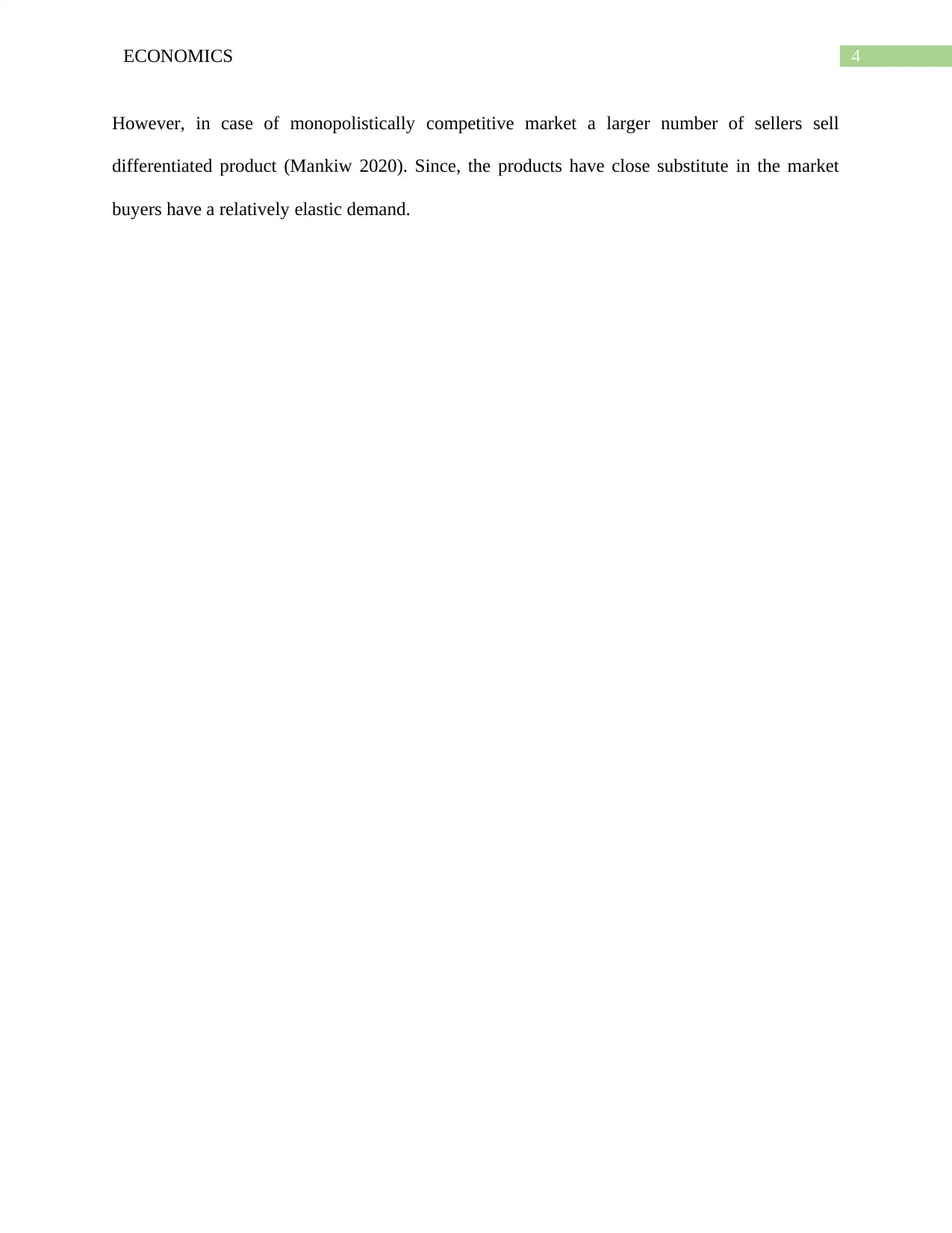
4ECONOMICS
However, in case of monopolistically competitive market a larger number of sellers sell
differentiated product (Mankiw 2020). Since, the products have close substitute in the market
buyers have a relatively elastic demand.
However, in case of monopolistically competitive market a larger number of sellers sell
differentiated product (Mankiw 2020). Since, the products have close substitute in the market
buyers have a relatively elastic demand.
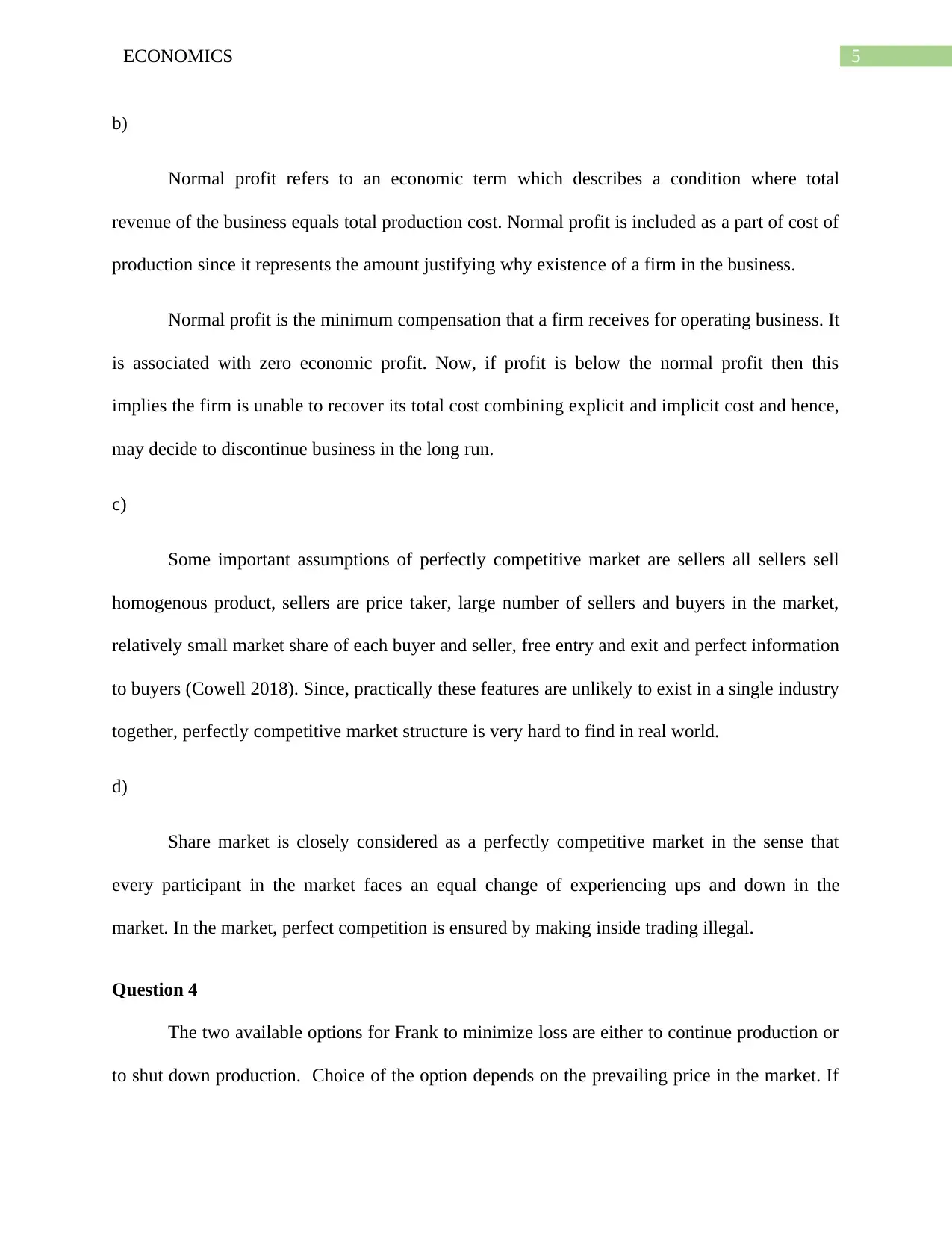
5ECONOMICS
b)
Normal profit refers to an economic term which describes a condition where total
revenue of the business equals total production cost. Normal profit is included as a part of cost of
production since it represents the amount justifying why existence of a firm in the business.
Normal profit is the minimum compensation that a firm receives for operating business. It
is associated with zero economic profit. Now, if profit is below the normal profit then this
implies the firm is unable to recover its total cost combining explicit and implicit cost and hence,
may decide to discontinue business in the long run.
c)
Some important assumptions of perfectly competitive market are sellers all sellers sell
homogenous product, sellers are price taker, large number of sellers and buyers in the market,
relatively small market share of each buyer and seller, free entry and exit and perfect information
to buyers (Cowell 2018). Since, practically these features are unlikely to exist in a single industry
together, perfectly competitive market structure is very hard to find in real world.
d)
Share market is closely considered as a perfectly competitive market in the sense that
every participant in the market faces an equal change of experiencing ups and down in the
market. In the market, perfect competition is ensured by making inside trading illegal.
Question 4
The two available options for Frank to minimize loss are either to continue production or
to shut down production. Choice of the option depends on the prevailing price in the market. If
b)
Normal profit refers to an economic term which describes a condition where total
revenue of the business equals total production cost. Normal profit is included as a part of cost of
production since it represents the amount justifying why existence of a firm in the business.
Normal profit is the minimum compensation that a firm receives for operating business. It
is associated with zero economic profit. Now, if profit is below the normal profit then this
implies the firm is unable to recover its total cost combining explicit and implicit cost and hence,
may decide to discontinue business in the long run.
c)
Some important assumptions of perfectly competitive market are sellers all sellers sell
homogenous product, sellers are price taker, large number of sellers and buyers in the market,
relatively small market share of each buyer and seller, free entry and exit and perfect information
to buyers (Cowell 2018). Since, practically these features are unlikely to exist in a single industry
together, perfectly competitive market structure is very hard to find in real world.
d)
Share market is closely considered as a perfectly competitive market in the sense that
every participant in the market faces an equal change of experiencing ups and down in the
market. In the market, perfect competition is ensured by making inside trading illegal.
Question 4
The two available options for Frank to minimize loss are either to continue production or
to shut down production. Choice of the option depends on the prevailing price in the market. If
⊘ This is a preview!⊘
Do you want full access?
Subscribe today to unlock all pages.

Trusted by 1+ million students worldwide
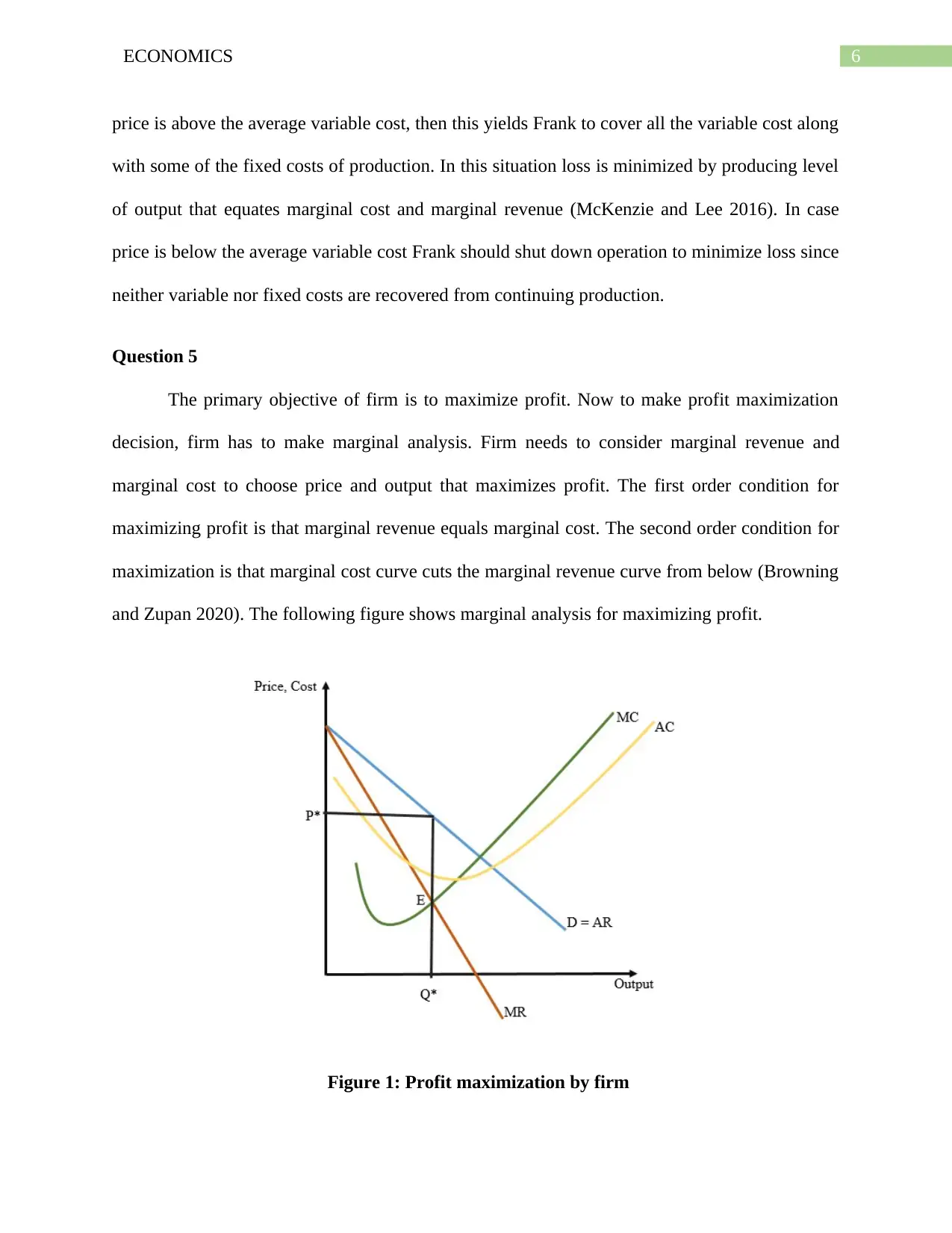
6ECONOMICS
price is above the average variable cost, then this yields Frank to cover all the variable cost along
with some of the fixed costs of production. In this situation loss is minimized by producing level
of output that equates marginal cost and marginal revenue (McKenzie and Lee 2016). In case
price is below the average variable cost Frank should shut down operation to minimize loss since
neither variable nor fixed costs are recovered from continuing production.
Question 5
The primary objective of firm is to maximize profit. Now to make profit maximization
decision, firm has to make marginal analysis. Firm needs to consider marginal revenue and
marginal cost to choose price and output that maximizes profit. The first order condition for
maximizing profit is that marginal revenue equals marginal cost. The second order condition for
maximization is that marginal cost curve cuts the marginal revenue curve from below (Browning
and Zupan 2020). The following figure shows marginal analysis for maximizing profit.
Figure 1: Profit maximization by firm
price is above the average variable cost, then this yields Frank to cover all the variable cost along
with some of the fixed costs of production. In this situation loss is minimized by producing level
of output that equates marginal cost and marginal revenue (McKenzie and Lee 2016). In case
price is below the average variable cost Frank should shut down operation to minimize loss since
neither variable nor fixed costs are recovered from continuing production.
Question 5
The primary objective of firm is to maximize profit. Now to make profit maximization
decision, firm has to make marginal analysis. Firm needs to consider marginal revenue and
marginal cost to choose price and output that maximizes profit. The first order condition for
maximizing profit is that marginal revenue equals marginal cost. The second order condition for
maximization is that marginal cost curve cuts the marginal revenue curve from below (Browning
and Zupan 2020). The following figure shows marginal analysis for maximizing profit.
Figure 1: Profit maximization by firm
Paraphrase This Document
Need a fresh take? Get an instant paraphrase of this document with our AI Paraphraser
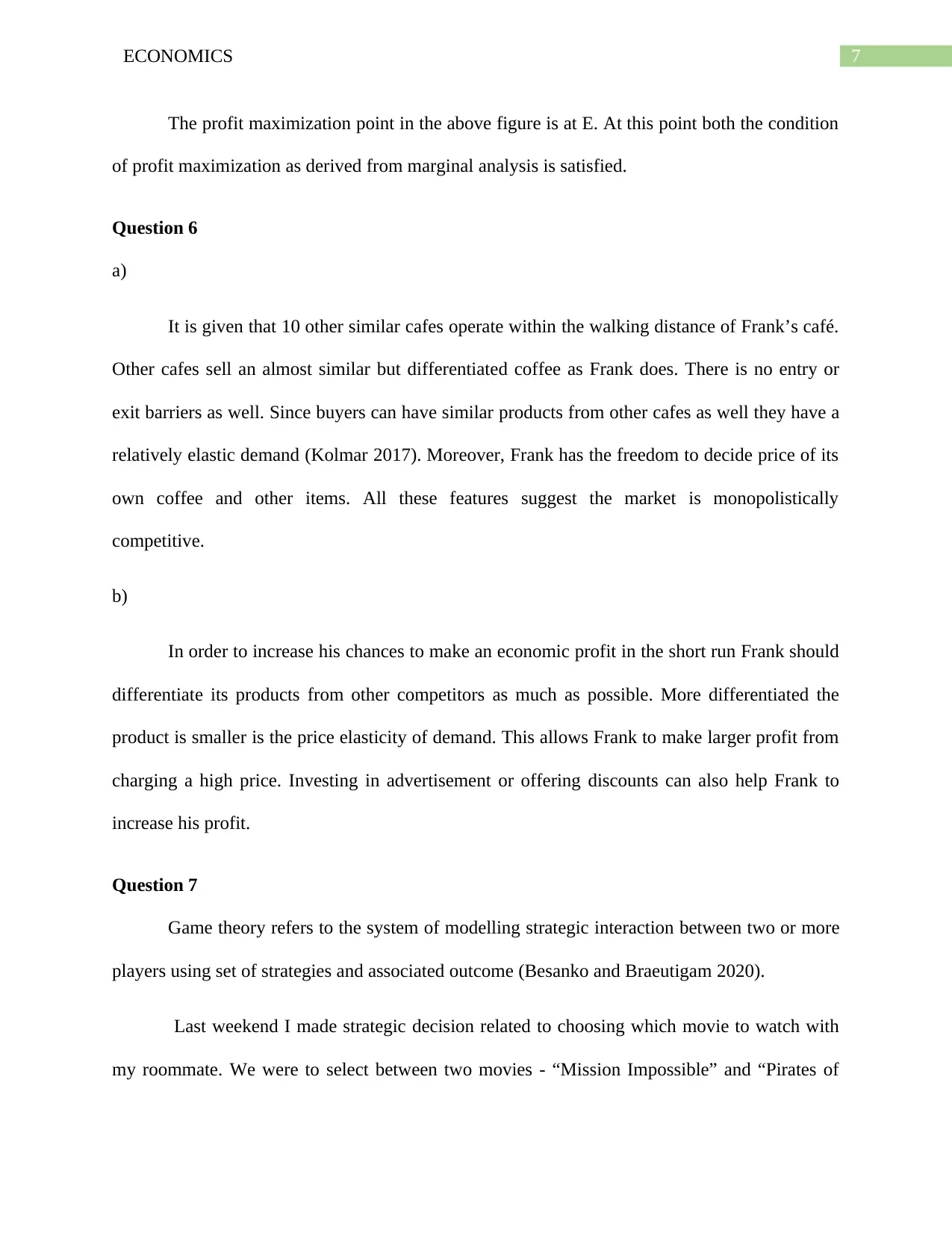
7ECONOMICS
The profit maximization point in the above figure is at E. At this point both the condition
of profit maximization as derived from marginal analysis is satisfied.
Question 6
a)
It is given that 10 other similar cafes operate within the walking distance of Frank’s café.
Other cafes sell an almost similar but differentiated coffee as Frank does. There is no entry or
exit barriers as well. Since buyers can have similar products from other cafes as well they have a
relatively elastic demand (Kolmar 2017). Moreover, Frank has the freedom to decide price of its
own coffee and other items. All these features suggest the market is monopolistically
competitive.
b)
In order to increase his chances to make an economic profit in the short run Frank should
differentiate its products from other competitors as much as possible. More differentiated the
product is smaller is the price elasticity of demand. This allows Frank to make larger profit from
charging a high price. Investing in advertisement or offering discounts can also help Frank to
increase his profit.
Question 7
Game theory refers to the system of modelling strategic interaction between two or more
players using set of strategies and associated outcome (Besanko and Braeutigam 2020).
Last weekend I made strategic decision related to choosing which movie to watch with
my roommate. We were to select between two movies - “Mission Impossible” and “Pirates of
The profit maximization point in the above figure is at E. At this point both the condition
of profit maximization as derived from marginal analysis is satisfied.
Question 6
a)
It is given that 10 other similar cafes operate within the walking distance of Frank’s café.
Other cafes sell an almost similar but differentiated coffee as Frank does. There is no entry or
exit barriers as well. Since buyers can have similar products from other cafes as well they have a
relatively elastic demand (Kolmar 2017). Moreover, Frank has the freedom to decide price of its
own coffee and other items. All these features suggest the market is monopolistically
competitive.
b)
In order to increase his chances to make an economic profit in the short run Frank should
differentiate its products from other competitors as much as possible. More differentiated the
product is smaller is the price elasticity of demand. This allows Frank to make larger profit from
charging a high price. Investing in advertisement or offering discounts can also help Frank to
increase his profit.
Question 7
Game theory refers to the system of modelling strategic interaction between two or more
players using set of strategies and associated outcome (Besanko and Braeutigam 2020).
Last weekend I made strategic decision related to choosing which movie to watch with
my roommate. We were to select between two movies - “Mission Impossible” and “Pirates of
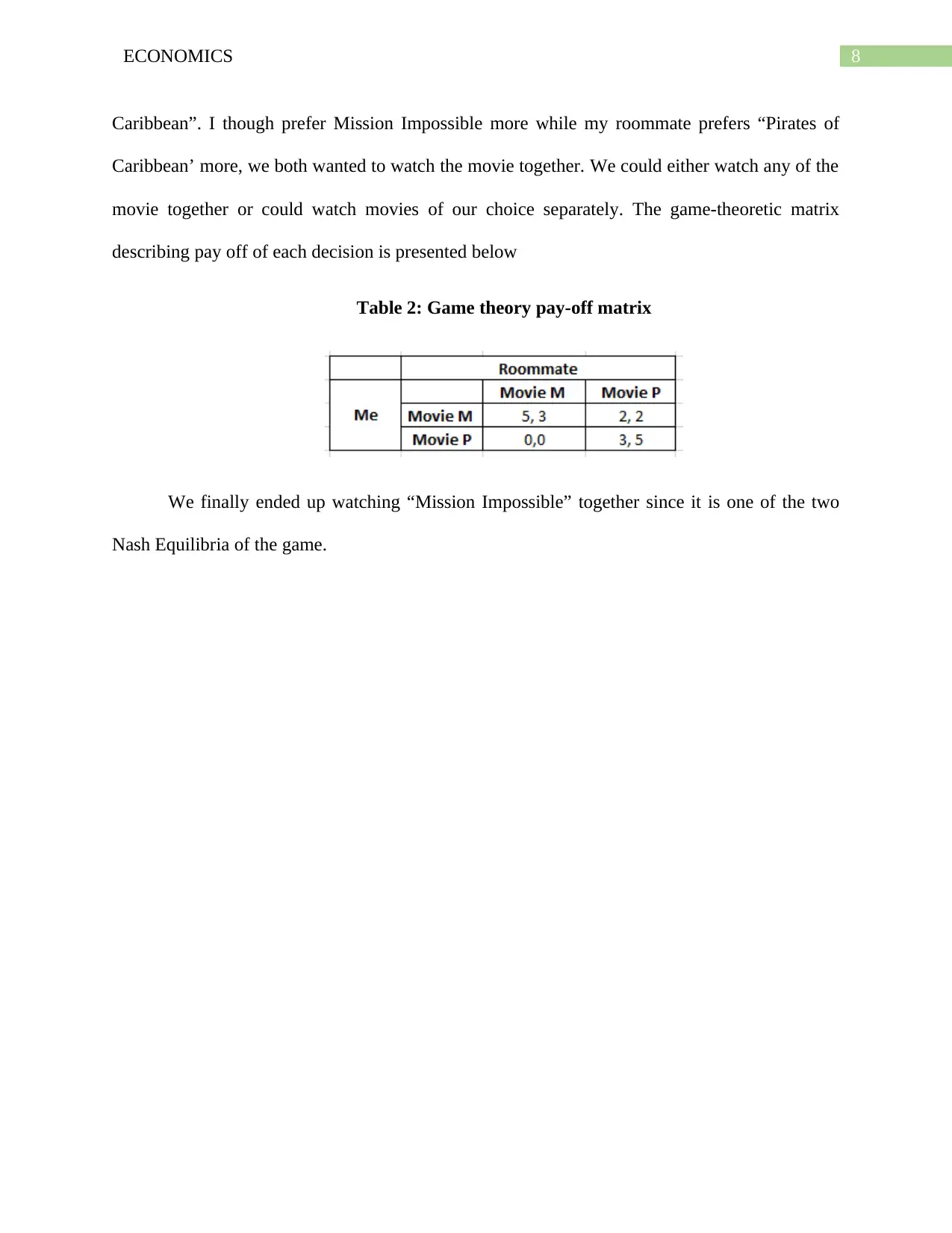
8ECONOMICS
Caribbean”. I though prefer Mission Impossible more while my roommate prefers “Pirates of
Caribbean’ more, we both wanted to watch the movie together. We could either watch any of the
movie together or could watch movies of our choice separately. The game-theoretic matrix
describing pay off of each decision is presented below
Table 2: Game theory pay-off matrix
We finally ended up watching “Mission Impossible” together since it is one of the two
Nash Equilibria of the game.
Caribbean”. I though prefer Mission Impossible more while my roommate prefers “Pirates of
Caribbean’ more, we both wanted to watch the movie together. We could either watch any of the
movie together or could watch movies of our choice separately. The game-theoretic matrix
describing pay off of each decision is presented below
Table 2: Game theory pay-off matrix
We finally ended up watching “Mission Impossible” together since it is one of the two
Nash Equilibria of the game.
⊘ This is a preview!⊘
Do you want full access?
Subscribe today to unlock all pages.

Trusted by 1+ million students worldwide
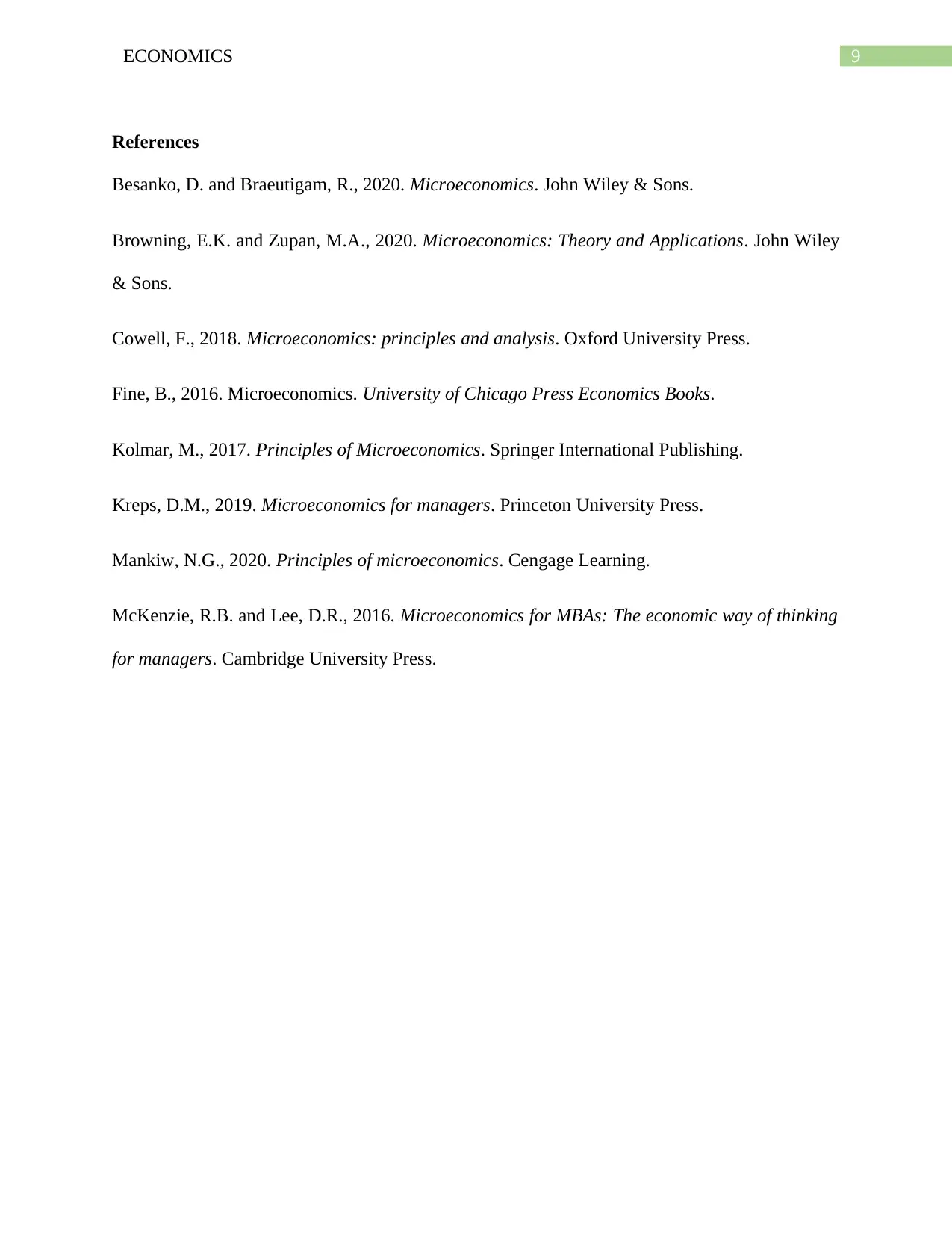
9ECONOMICS
References
Besanko, D. and Braeutigam, R., 2020. Microeconomics. John Wiley & Sons.
Browning, E.K. and Zupan, M.A., 2020. Microeconomics: Theory and Applications. John Wiley
& Sons.
Cowell, F., 2018. Microeconomics: principles and analysis. Oxford University Press.
Fine, B., 2016. Microeconomics. University of Chicago Press Economics Books.
Kolmar, M., 2017. Principles of Microeconomics. Springer International Publishing.
Kreps, D.M., 2019. Microeconomics for managers. Princeton University Press.
Mankiw, N.G., 2020. Principles of microeconomics. Cengage Learning.
McKenzie, R.B. and Lee, D.R., 2016. Microeconomics for MBAs: The economic way of thinking
for managers. Cambridge University Press.
References
Besanko, D. and Braeutigam, R., 2020. Microeconomics. John Wiley & Sons.
Browning, E.K. and Zupan, M.A., 2020. Microeconomics: Theory and Applications. John Wiley
& Sons.
Cowell, F., 2018. Microeconomics: principles and analysis. Oxford University Press.
Fine, B., 2016. Microeconomics. University of Chicago Press Economics Books.
Kolmar, M., 2017. Principles of Microeconomics. Springer International Publishing.
Kreps, D.M., 2019. Microeconomics for managers. Princeton University Press.
Mankiw, N.G., 2020. Principles of microeconomics. Cengage Learning.
McKenzie, R.B. and Lee, D.R., 2016. Microeconomics for MBAs: The economic way of thinking
for managers. Cambridge University Press.
1 out of 10
Related Documents
Your All-in-One AI-Powered Toolkit for Academic Success.
+13062052269
info@desklib.com
Available 24*7 on WhatsApp / Email
![[object Object]](/_next/static/media/star-bottom.7253800d.svg)
Unlock your academic potential
Copyright © 2020–2025 A2Z Services. All Rights Reserved. Developed and managed by ZUCOL.





